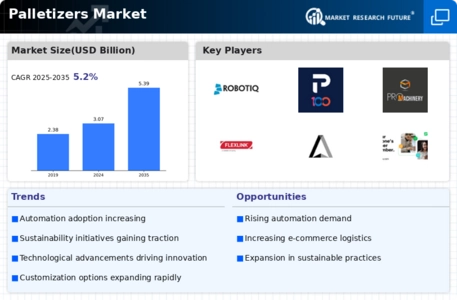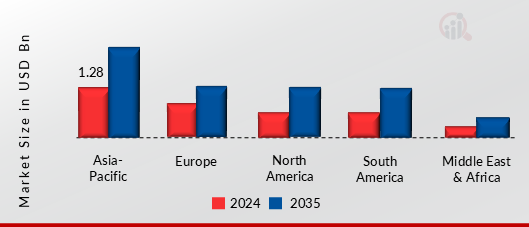-
EXECUTIVE SUMMARY
-
MARKET INTRODUCTION
-
2.1
-
DEFINITION
-
SCOPE OF THE STUDY
-
RESEARCH OBJECTIVE
-
MARKET
-
STRUCTURE
-
RESEARCH METHODOLOGY
-
OVERVIEW
-
DATA FLOW
-
3.2.1
-
DATA MINING PROCESS
-
PURCHASED DATABASE:
-
SECONDARY SOURCES:
- SECONDARY RESEARCH DATA FLOW:
-
PRIMARY RESEARCH:
- PRIMARY
- PRIMARY RESEARCH: NUMBER OF INTERVIEWS CONDUCTED
- PRIMARY RESEARCH: REGIONAL COVERAGE
-
RESEARCH DATA FLOW:
-
APPROACHES FOR MARKET SIZE
- REVENUE ANALYSIS APPROACH
-
ESTIMATION:
-
DATA FORECASTING
-
3.7.1
-
DATA FORECASTING TECHNIQUE
-
DATA MODELING
- MICROECONOMIC FACTOR
- DATA MODELING:
-
ANALYSIS:
-
TEAMS AND ANALYST CONTRIBUTION
-
4
-
MARKET DYNAMICS
-
INTRODUCTION
-
DRIVERS
- RAPID EXPANSION
- SURGE IN PRODUCTION VOLUMES IN INDUSTRIES
- INCREASING
- DRIVER
-
OF E-COMMERCE AND WAREHOUSING
-
SUCH AS FOOD AND BEVERAGE, PHARMACEUTICALS, AND CONSUMER GOODS
-
DEMAND FOR AUTOMATION IN MANUFACTURING, PACKAGING, AND LOGISTICS
-
IMPACT ANALYSIS
-
RESTRAINTS
- HIGH INITIAL INVESTMENT REQUIRED
- COMPLEXITY OF INTEGRATION INTO EXISTING
- RESTRAINT IMPACT
-
FOR ADVANCED PALLETIZING SYSTEMS
-
MANUFACTURING PROCESSES CAN BE COMPLEX AND TIME-CONSUMING
-
ANALYSIS
-
OPPORTUNITY
- GROWING DEMAND FOR CUSTOMIZATION AND FLEXIBILITY
-
FOR PALLETIZERS
-
IMPACT ANALYSIS OF COVID-19
- IMPACT ON OVERALL
- IMPACT ON PALLETIZERS
- IMPACT ON SUPPLY CHAIN OF PALLETIZER
- IMPACT ON MARKET DEMAND OF PALLETIZERS
- IMPACT ON PRICING OF PALLETIZERS
-
PACKAGING INDUSTRY
-
MARKET
-
OF KEY RAW MATERIALS
-
MARKET FACTOR ANALYSIS
-
5.1
-
SUPPLY CHAIN ANALYSIS
-
FIVE FORCES MODEL
-
POWER OF SUPPLIERS (MODERATE)
-
5.2.4
-
BARGAINING POWER OF BUYERS (MODERATE)
-
RAW MATERIAL/COMPONENTS PROVIDERS
-
MANUFACTURING
-
DISTRIBUTORS & RETAILERS
-
APPLICATION
-
PORTER’S
- THREAT OF NEW ENTRANTS (MODERATE)
- BARGAINING
- THREAT OF SUBSTITUTES (LOW)
- INTENSITY OF RIVALRY (HIGH)
-
GLOBAL PALLETIZERS MARKET, BY PALLETIZER TYPE
-
INTRODUCTION
-
6.2
-
CONVENTIONAL
-
ROBOTIC
-
COBOT PALLETIZER
-
GLOBAL PALLETIZERS
-
MARKET, BY AUTOMATION LEVEL
-
INTRODUCTION
-
FULLY AUTOMATED
-
7.3
-
SEMI AUTOMATED
-
MANUAL
-
GLOBAL PALLETIZERS MARKET, BY APPLICATION
-
INTRODUCTION
-
FOOD & BEVERAGE
-
PHARMACEUTICAL
-
8.4
-
CONSUMER GOODS
-
INDUSTRIAL GOODS
-
OTHERS
-
GLOBAL PALLETIZERS
-
MARKET, BY REGION
-
OVERVIEW
-
NORTH AMERICA
- US
- MEXICO
-
9.2.2
-
CANADA
-
EUROPE
- GERMANY
- UK
- RUSSIA
- ITALY
- SPAIN
- REST OF EUROPE
-
9.3.3
-
FRANCE
-
ASIA-PACIFIC
- CHINA
- INDIA
- JAPAN
- MALAYSIA
- THAILAND
- INDONESIA
- REST OF ASIA-PACIFIC
-
9.4.4
-
SOUTH KOREA
-
9.4.8
-
AUSTRALIA
-
MIDDLE EAST & AFRICA (MEA)
- GCC COUNTRIES
- SOUTH AFRICA
- REST OF MEA
-
SOUTH
- BRAZIL
- ARGENTINA
- PERU
- CHILE
- REST OF SOUTH AMERICA
-
AMERICA
-
COMPETITIVE LANDSCAPE
-
INTRODUCTION
-
COMPETITOR DASHBOARD
-
THE LEADING PLAYER IN TERMS OF THE NUMBER
-
OF RECENT DEVELOPMENTS IN THE MARKET
-
KEY DEVELOPMENTS & GROWTH STRATEGIES
- PRODUCT LAUNCH
- CONTRACTS, JOINT VENTURE, COLLABORATION &
- EXPANSION & INVESTMENT
-
PARNERSHIP
-
COMPANY PROFILES
-
11.1
-
ONEXIA INC.
-
11.1.3
-
PRODUCTS OFFERED
-
11.1.6
-
KEY STRATEGIES
-
11.2.2
-
FINANCIAL OVERVIEW
-
11.3.1
-
COMPANY OVERVIEW
-
11.4.3
-
PRODUCTS OFFERED
-
11.4.6
-
KEY STRATEGIES
-
11.5.2
-
FINANCIAL OVERVIEW
-
11.6.1
-
COMPANY OVERVIEW
-
11.7.3
-
PRODUCTS OFFERED
-
11.7.6
-
KEY STRATEGIES
-
OVERVIEW
-
ANALYSIS
-
OVERVIEW
-
11.9.4
-
KEY DEVELOPMENTS
-
11.10
-
SIDEL
-
11.10.3
-
PRODUCTS OFFERED
-
11.10.6
-
KEY STRATEGIES
-
\r\n
-
\r\n
-
COMPANY OVERVIEW
-
FINANCIAL OVERVIEW
-
KEY DEVELOPMENTS
-
SWOT ANALYSIS
-
COLUMBIA/OKURA, LLC
- COMPANY OVERVIEW
- PRODUCTS OFFERED
- KEY DEVELOPMENTS
- SWOT ANALYSIS
- KEY STRATEGIES
-
VENTION
- FINANCIAL OVERVIEW
- PRODUCTS OFFERED
- KEY DEVELOPMENTS
- SWOT ANALYSIS
- KEY STRATEGIES
-
ROBOTIQ
- COMPANY OVERVIEW
- FINANCIAL OVERVIEW
- KEY DEVELOPMENTS
- SWOT ANALYSIS
-
PREMIER TECH LTD.
- COMPANY OVERVIEW
- PRODUCTS OFFERED
- KEY DEVELOPMENTS
- SWOT ANALYSIS
- KEY STRATEGIES
-
PROMACH INC.
- FINANCIAL OVERVIEW
- PRODUCTS OFFERED
- KEY DEVELOPMENTS
- SWOT ANALYSIS
- KEY STRATEGIES
-
FLEXLINK
- COMPANY OVERVIEW
- FINANCIAL OVERVIEW
- KEY DEVELOPMENTS
- SWOT ANALYSIS
-
FORTNA INC.
- COMPANY OVERVIEW
- FINANCIAL
- PRODUCTS OFFERED
- KEY DEVELOPMENTS
- SWOT
- KEY STRATEGIES
-
PACTEON GROUP
- COMPANY
- FINANCIAL OVERVIEW
- PRODUCTS OFFERED
- SWOT ANALYSIS
- KEY STRATEGIES
- COMPANY OVERVIEW
- FINANCIAL OVERVIEW
- KEY DEVELOPMENTS
- SWOT ANALYSIS
-
LIST OF TABLES
-
TABLE
-
QFD MODELING FOR MARKET SHARE ASSESSMENT
-
GLOBAL PALLETIZERS MARKET,
-
BY PALLETIZER TYPE, 2020-2035 (USD BILLION)
-
GLOBAL PALLETIZERS MARKET,
-
BY AUTOMATION LEVEL, 2020-2035 (USD BILLION)
-
GLOBAL PALLETIZERS MARKET,
-
BY APPLICATION, 2020-2035 (USD BILLION)
-
GLOBAL PALLETIZERS MARKET,
-
BY FOOD & BEVERAGES, 2020-2035 (USD BILLION)
-
GLOBAL PALLETIZERS
-
MARKET, BY CONSUMER GOODS, 2020-2035 (USD BILLION)
-
GLOBAL PALLETIZERS
-
MARKET, BY REGION, 2020-2035 (USD BILLION)
-
NORTH AMERICA: PALLETIZERS
-
MARKET, BY COUNTRY, 2020-2035 (USD BILLION)
-
NORTH AMERICA: PALLETIZERS
-
MARKET, BY PALLETIZER TYPE, 2020-2035 (USD BILLION)
-
NORTH AMERICA:
-
PALLETIZERS MARKET, BY AUTOMATION LEVEL, 2020-2035 (USD BILLION)
-
NORTH
-
AMERICA: PALLETIZERS MARKET, BY APPLICATION, 2020-2035 (USD BILLION)
-
TABLE
-
NORTH AMERICA: PALLETIZERS MARKET, BY FOOD & BEVERAGES, 2020-2035 (USD BILLION)
-
NORTH AMERICA: PALLETIZERS MARKET, BY CONSUMER GOODS, 2020-2035 (USD
-
BILLION)
-
US: PALLETIZERS MARKET, BY PALLETIZER TYPE, 2020-2035 (USD
-
BILLION)
-
US: PALLETIZERS MARKET, BY AUTOMATION LEVEL, 2020-2035 (USD
-
BILLION)
-
US: PALLETIZERS MARKET, BY APPLICATION, 2020-2035 (USD BILLION)
-
US: PALLETIZERS MARKET, BY FOOD & BEVERAGES, 2020-2035 (USD BILLION)
-
US: PALLETIZERS MARKET, BY CONSUMER GOODS, 2020-2035 (USD BILLION)
-
CANADA: PALLETIZERS MARKET, BY PALLETIZER TYPE, 2020-2035 (USD BILLION)
-
CANADA: PALLETIZERS MARKET, BY AUTOMATION LEVEL, 2020-2035 (USD BILLION)
-
CANADA: PALLETIZERS MARKET, BY APPLICATION, 2020-2035 (USD BILLION)
-
CANADA: PALLETIZERS MARKET, BY FOOD & BEVERAGES, 2020-2035 (USD BILLION)
-
CANADA: PALLETIZERS MARKET, BY CONSUMER GOODS, 2020-2035 (USD BILLION)
-
MEXICO: PALLETIZERS MARKET, BY PALLETIZER TYPE, 2020-2035 (USD BILLION)
-
MEXICO: PALLETIZERS MARKET, BY AUTOMATION LEVEL, 2020-2035 (USD BILLION)
-
MEXICO: PALLETIZERS MARKET, BY APPLICATION, 2020-2035 (USD BILLION)
-
MEXICO: PALLETIZERS MARKET, BY FOOD & BEVERAGES, 2020-2035 (USD BILLION)
-
MEXICO: PALLETIZERS MARKET, BY CONSUMER GOODS, 2020-2035 (USD BILLION)
-
EUROPE: PALLETIZERS MARKET, BY COUNTRY, 2020-2035 (USD BILLION)
-
TABLE
-
EUROPE: PALLETIZERS MARKET, BY PALLETIZER TYPE, 2020-2035 (USD BILLION)
-
TABLE
-
EUROPE: PALLETIZERS MARKET, BY AUTOMATION LEVEL, 2020-2035 (USD BILLION)
-
TABLE
-
EUROPE: PALLETIZERS MARKET, BY APPLICATION, 2020-2035 (USD BILLION)
-
TABLE
-
EUROPE: PALLETIZERS MARKET, BY FOOD & BEVERAGES, 2020-2035 (USD BILLION)
-
EUROPE: PALLETIZERS MARKET, BY CONSUMER GOODS, 2020-2035 (USD BILLION)
-
GERMANY: PALLETIZERS MARKET, BY PALLETIZER TYPE, 2020-2035 (USD BILLION)
-
GERMANY: PALLETIZERS MARKET, BY AUTOMATION LEVEL, 2020-2035 (USD BILLION)
-
GERMANY: PALLETIZERS MARKET, BY APPLICATION, 2020-2035 (USD BILLION)
-
GERMANY: PALLETIZERS MARKET, BY FOOD & BEVERAGES, 2020-2035 (USD
-
BILLION)
-
GERMANY: PALLETIZERS MARKET, BY CONSUMER GOODS, 2020-2035
-
(USD BILLION)
-
UK: PALLETIZERS MARKET, BY PALLETIZER TYPE, 2020-2035
-
(USD BILLION)
-
UK: PALLETIZERS MARKET, BY AUTOMATION LEVEL, 2020-2035
-
(USD BILLION)
-
UK: PALLETIZERS MARKET, BY APPLICATION, 2020-2035 (USD
-
BILLION)
-
UK: PALLETIZERS MARKET, BY FOOD & BEVERAGES, 2020-2035
-
(USD BILLION)
-
UK: PALLETIZERS MARKET, BY CONSUMER GOODS, 2020-2035
-
(USD BILLION)
-
FRANCE: PALLETIZERS MARKET, BY PALLETIZER TYPE, 2020-2035
-
(USD BILLION)
-
FRANCE: PALLETIZERS MARKET, BY AUTOMATION LEVEL, 2020-2035
-
(USD BILLION)
-
FRANCE: PALLETIZERS MARKET, BY APPLICATION, 2020-2035
-
(USD BILLION)
-
FRANCE: PALLETIZERS MARKET, BY FOOD & BEVERAGES,
-
FRANCE: PALLETIZERS MARKET, BY CONSUMER GOODS,
-
RUSSIA: PALLETIZERS MARKET, BY PALLETIZER
-
TYPE, 2020-2035 (USD BILLION)
-
RUSSIA: PALLETIZERS MARKET, BY AUTOMATION
-
LEVEL, 2020-2035 (USD BILLION)
-
RUSSIA: PALLETIZERS MARKET, BY APPLICATION,
-
RUSSIA: PALLETIZERS MARKET, BY FOOD &
-
BEVERAGES, 2020-2035 (USD BILLION)
-
RUSSIA: PALLETIZERS MARKET, BY
-
CONSUMER GOODS, 2020-2035 (USD BILLION)
-
ITALY: PALLETIZERS MARKET,
-
BY PALLETIZER TYPE, 2020-2035 (USD BILLION)
-
ITALY: PALLETIZERS MARKET,
-
BY AUTOMATION LEVEL, 2020-2035 (USD BILLION)
-
ITALY: PALLETIZERS MARKET,
-
BY APPLICATION, 2020-2035 (USD BILLION)
-
ITALY: PALLETIZERS MARKET,
-
BY FOOD & BEVERAGES, 2020-2035 (USD BILLION)
-
ITALY: PALLETIZERS
-
MARKET, BY CONSUMER GOODS, 2020-2035 (USD BILLION)
-
SPAIN: PALLETIZERS
-
MARKET, BY PALLETIZER TYPE, 2020-2035 (USD BILLION)
-
SPAIN: PALLETIZERS
-
MARKET, BY AUTOMATION LEVEL, 2020-2035 (USD BILLION)
-
SPAIN: PALLETIZERS
-
MARKET, BY APPLICATION, 2020-2035 (USD BILLION)
-
SPAIN: PALLETIZERS
-
MARKET, BY FOOD & BEVERAGES, 2020-2035 (USD BILLION)
-
SPAIN: PALLETIZERS
-
MARKET, BY CONSUMER GOODS, 2020-2035 (USD BILLION)
-
REST OF EUROPE:
-
PALLETIZERS MARKET, BY PALLETIZER TYPE, 2020-2035 (USD BILLION)
-
REST
-
OF EUROPE: PALLETIZERS MARKET, BY AUTOMATION LEVEL, 2020-2035 (USD BILLION)
-
TABLE
-
REST OF EUROPE: PALLETIZERS MARKET, BY APPLICATION, 2020-2035 (USD BILLION)
-
REST OF EUROPE: PALLETIZERS MARKET, BY FOOD & BEVERAGES, 2020-2035
-
(USD BILLION)
-
REST OF EUROPE: PALLETIZERS MARKET, BY CONSUMER GOODS,
-
ASIA-PACIFIC: PALLETIZERS MARKET, BY COUNTRY,
-
ASIA-PACIFIC: PALLETIZERS MARKET, BY PALLETIZER
-
TYPE, 2020-2035 (USD BILLION)
-
ASIA-PACIFIC: PALLETIZERS MARKET, BY
-
AUTOMATION LEVEL, 2020-2035 (USD BILLION)
-
EU ASIA-PACIFIC ROPE: PALLETIZERS
-
MARKET, BY APPLICATION, 2020-2035 (USD BILLION)
-
ASIA-PACIFIC: PALLETIZERS
-
MARKET, BY FOOD & BEVERAGES, 2020-2035 (USD BILLION)
-
ASIA-PACIFIC:
-
PALLETIZERS MARKET, BY CONSUMER GOODS, 2020-2035 (USD BILLION)
-
CHINA:
-
PALLETIZERS MARKET, BY PALLETIZER TYPE, 2020-2035 (USD BILLION)
-
CHINA:
-
PALLETIZERS MARKET, BY AUTOMATION LEVEL, 2020-2035 (USD BILLION)
-
CHINA:
-
PALLETIZERS MARKET, BY APPLICATION, 2020-2035 (USD BILLION)
-
CHINA:
-
PALLETIZERS MARKET, BY FOOD & BEVERAGES, 2020-2035 (USD BILLION)
-
TABLE
-
CHINA: PALLETIZERS MARKET, BY CONSUMER GOODS, 2020-2035 (USD BILLION)
-
TABLE
-
INDIA: PALLETIZERS MARKET, BY PALLETIZER TYPE, 2020-2035 (USD BILLION)
-
TABLE
-
INDIA: PALLETIZERS MARKET, BY AUTOMATION LEVEL, 2020-2035 (USD BILLION)
-
TABLE
-
INDIA: PALLETIZERS MARKET, BY APPLICATION, 2020-2035 (USD BILLION)
-
TABLE
-
INDIA: PALLETIZERS MARKET, BY FOOD & BEVERAGES, 2020-2035 (USD BILLION)
-
INDIA: PALLETIZERS MARKET, BY CONSUMER GOODS, 2020-2035 (USD BILLION)
-
JAPAN: PALLETIZERS MARKET, BY PALLETIZER TYPE, 2020-2035 (USD BILLION)
-
JAPAN: PALLETIZERS MARKET, BY AUTOMATION LEVEL, 2020-2035 (USD BILLION)
-
JAPAN: PALLETIZERS MARKET, BY APPLICATION, 2020-2035 (USD BILLION)
-
JAPAN: PALLETIZERS MARKET, BY FOOD & BEVERAGES, 2020-2035 (USD BILLION)
-
JAPAN: PALLETIZERS MARKET, BY CONSUMER GOODS, 2020-2035 (USD BILLION)
-
SOUTH KOREA: PALLETIZERS MARKET, BY PALLETIZER TYPE, 2020-2035 (USD BILLION)
-
SOUTH KOREA: PALLETIZERS MARKET, BY AUTOMATION LEVEL, 2020-2035 (USD
-
BILLION)
-
SOUTH KOREA: PALLETIZERS MARKET, BY APPLICATION, 2020-2035
-
(USD BILLION)
-
SOUTH KOREA: PALLETIZERS MARKET, BY FOOD & BEVERAGES,
-
SOUTH KOREA: PALLETIZERS MARKET, BY CONSUMER
-
GOODS, 2020-2035 (USD BILLION)
-
MALAYSIA: PALLETIZERS MARKET, BY PALLETIZER
-
TYPE, 2020-2035 (USD BILLION)
-
MALAYSIA: PALLETIZERS MARKET, BY AUTOMATION
-
LEVEL, 2020-2035 (USD BILLION)
-
MALAYSIA: PALLETIZERS MARKET, BY APPLICATION,
-
MALAYSIA: PALLETIZERS MARKET, BY FOOD &
-
BEVERAGES, 2020-2035 (USD BILLION)
-
MALAYSIA: PALLETIZERS MARKET,
-
BY CONSUMER GOODS, 2020-2035 (USD BILLION)
-
THAILAND: PALLETIZERS
-
MARKET, BY PALLETIZER TYPE, 2020-2035 (USD BILLION)
-
THAILAND: PALLETIZERS
-
MARKET, BY AUTOMATION LEVEL, 2020-2035 (USD BILLION)
-
THAILAND: PALLETIZERS
-
MARKET, BY APPLICATION, 2020-2035 (USD BILLION)
-
THAILAND: PALLETIZERS
-
MARKET, BY FOOD & BEVERAGES, 2020-2035 (USD BILLION)
-
THAILAND:
-
PALLETIZERS MARKET, BY CONSUMER GOODS, 2020-2035 (USD BILLION)
-
INDONESIA:
-
PALLETIZERS MARKET, BY PALLETIZER TYPE, 2020-2035 (USD BILLION)
-
INDONESIA:
-
PALLETIZERS MARKET, BY AUTOMATION LEVEL, 2020-2035 (USD BILLION)
-
TABLE 108
-
INDONESIA: PALLETIZERS MARKET, BY APPLICATION, 2020-2035 (USD BILLION)
-
TABLE
-
INDONESIA: PALLETIZERS MARKET, BY FOOD & BEVERAGES, 2020-2035 (USD BILLION)
-
INDONESIA: PALLETIZERS MARKET, BY CONSUMER GOODS, 2020-2035 (USD BILLION)
-
AUSTRALIA: PALLETIZERS MARKET, BY PALLETIZER TYPE, 2020-2035 (USD BILLION)
-
AUSTRALIA: PALLETIZERS MARKET, BY AUTOMATION LEVEL, 2020-2035 (USD BILLION)
-
AUSTRALIA: PALLETIZERS MARKET, BY APPLICATION, 2020-2035 (USD BILLION)
-
AUSTRALIA: PALLETIZERS MARKET, BY FOOD & BEVERAGES, 2020-2035 (USD
-
BILLION)
-
AUSTRALIA: PALLETIZERS MARKET, BY CONSUMER GOODS, 2020-2035
-
(USD BILLION)
-
REST OF ASIA-PACIFIC: PALLETIZERS MARKET, BY PALLETIZER
-
TYPE, 2020-2035 (USD BILLION)
-
REST OF ASIA-PACIFIC: PALLETIZERS MARKET,
-
BY AUTOMATION LEVEL, 2020-2035 (USD BILLION)
-
REST OF ASIA-PACIFIC:
-
PALLETIZERS MARKET, BY APPLICATION, 2020-2035 (USD BILLION)
-
REST
-
OF ASIA-PACIFIC: PALLETIZERS MARKET, BY FOOD & BEVERAGES, 2020-2035 (USD BILLION)
-
REST OF ASIA-PACIFIC: PALLETIZERS MARKET, BY CONSUMER GOODS, 2020-2035
-
(USD BILLION)
-
MIDDLE EAST & AFRICA: PALLETIZERS MARKET, BY COUNTRY,
-
MIDDLE EAST & AFRICA: PALLETIZERS MARKET,
-
BY PALLETIZER TYPE, 2020-2035 (USD BILLION)
-
MIDDLE EAST & AFRICA:
-
PALLETIZERS MARKET, BY AUTOMATION LEVEL, 2020-2035 (USD BILLION)
-
TABLE 124
-
MIDDLE EAST & AFRICA: PALLETIZERS MARKET, BY APPLICATION, 2020-2035 (USD BILLION)
-
MIDDLE EAST & AFRICA: PALLETIZERS MARKET, BY FOOD & BEVERAGES,
-
MIDDLE EAST & AFRICA: PALLETIZERS MARKET,
-
BY CONSUMER GOODS, 2020-2035 (USD BILLION)
-
GCC COUNTRIES: PALLETIZERS
-
MARKET, BY PALLETIZER TYPE, 2020-2035 (USD BILLION)
-
GCC COUNTRIES:
-
PALLETIZERS MARKET, BY AUTOMATION LEVEL, 2020-2035 (USD BILLION)
-
TABLE 129
-
GCC COUNTRIES: PALLETIZERS MARKET, BY APPLICATION, 2020-2035 (USD BILLION)
-
TABLE
-
GCC COUNTRIES: PALLETIZERS MARKET, BY FOOD & BEVERAGES, 2020-2035 (USD BILLION)
-
GCC COUNTRIES: PALLETIZERS MARKET, BY CONSUMER GOODS, 2020-2035 (USD
-
BILLION)
-
SOUTH AFRICA: PALLETIZERS MARKET, BY PALLETIZER TYPE, 2020-2035
-
(USD BILLION)
-
SOUTH AFRICA: PALLETIZERS MARKET, BY AUTOMATION LEVEL,
-
SOUTH AFRICA: PALLETIZERS MARKET, BY APPLICATION,
-
SOUTH AFRICA: PALLETIZERS MARKET, BY FOOD
-
& BEVERAGES, 2020-2035 (USD BILLION)
-
SOUTH AFRICA: PALLETIZERS
-
MARKET, BY CONSUMER GOODS, 2020-2035 (USD BILLION)
-
REST OF MEA: PALLETIZERS
-
MARKET, BY PALLETIZER TYPE, 2020-2035 (USD BILLION)
-
REST OF MEA:
-
PALLETIZERS MARKET, BY AUTOMATION LEVEL, 2020-2035 (USD BILLION)
-
TABLE 139
-
REST OF MEA: PALLETIZERS MARKET, BY APPLICATION, 2020-2035 (USD BILLION)
-
TABLE
-
REST OF MEA: PALLETIZERS MARKET, BY FOOD & BEVERAGES, 2020-2035 (USD BILLION)
-
REST OF MEA: PALLETIZERS MARKET, BY CONSUMER GOODS, 2020-2035 (USD BILLION)
-
SOUTH AMERICA: PALLETIZERS MARKET, BY COUNTRY, 2020-2035 (USD BILLION)
-
SOUTH AMERICA: PALLETIZERS MARKET, BY PALLETIZER TYPE, 2020-2035 (USD
-
BILLION)
-
SOUTH AMERICA: PALLETIZERS MARKET, BY AUTOMATION LEVEL,
-
SOUTH AMERICA: PALLETIZERS MARKET, BY APPLICATION,
-
SOUTH AMERICA: PALLETIZERS MARKET, BY FOOD
-
& BEVERAGES, 2020-2035 (USD BILLION)
-
SOUTH AMERICA: PALLETIZERS
-
MARKET, BY CONSUMER GOODS, 2020-2035 (USD BILLION)
-
BRAZIL: PALLETIZERS
-
MARKET, BY PALLETIZER TYPE, 2020-2035 (USD BILLION)
-
BRAZIL: PALLETIZERS
-
MARKET, BY AUTOMATION LEVEL, 2020-2035 (USD BILLION)
-
BRAZIL: PALLETIZERS
-
MARKET, BY APPLICATION, 2020-2035 (USD BILLION)
-
BRAZIL: PALLETIZERS
-
MARKET, BY FOOD & BEVERAGES, 2020-2035 (USD BILLION)
-
BRAZIL:
-
PALLETIZERS MARKET, BY CONSUMER GOODS, 2020-2035 (USD BILLION)
-
ARGENTINA:
-
PALLETIZERS MARKET, BY PALLETIZER TYPE, 2020-2035 (USD BILLION)
-
ARGENTINA:
-
PALLETIZERS MARKET, BY AUTOMATION LEVEL, 2020-2035 (USD BILLION)
-
TABLE 155
-
ARGENTINA: PALLETIZERS MARKET, BY APPLICATION, 2020-2035 (USD BILLION)
-
TABLE
-
ARGENTINA: PALLETIZERS MARKET, BY FOOD & BEVERAGES, 2020-2035 (USD BILLION)
-
ARGENTINA: PALLETIZERS MARKET, BY CONSUMER GOODS, 2020-2035 (USD BILLION)
-
PERU: PALLETIZERS MARKET, BY PALLETIZER TYPE, 2020-2035 (USD BILLION)
-
PERU: PALLETIZERS MARKET, BY AUTOMATION LEVEL, 2020-2035 (USD BILLION)
-
PERU: PALLETIZERS MARKET, BY APPLICATION, 2020-2035 (USD BILLION)
-
PERU: PALLETIZERS MARKET, BY FOOD & BEVERAGES, 2020-2035 (USD BILLION)
-
PERU: PALLETIZERS MARKET, BY CONSUMER GOODS, 2020-2035 (USD BILLION)
-
CHILE: PALLETIZERS MARKET, BY PALLETIZER TYPE, 2020-2035 (USD BILLION)
-
CHILE: PALLETIZERS MARKET, BY AUTOMATION LEVEL, 2020-2035 (USD BILLION)
-
CHILE: PALLETIZERS MARKET, BY APPLICATION, 2020-2035 (USD BILLION)
-
CHILE: PALLETIZERS MARKET, BY FOOD & BEVERAGES, 2020-2035 (USD BILLION)
-
CHILE: PALLETIZERS MARKET, BY CONSUMER GOODS, 2020-2035 (USD BILLION)
-
REST OF SOUTH AMERICA: PALLETIZERS MARKET, BY PALLETIZER TYPE, 2020-2035
-
(USD BILLION)
-
REST OF SOUTH AMERICA: PALLETIZERS MARKET, BY AUTOMATION
-
LEVEL, 2020-2035 (USD BILLION)
-
REST OF SOUTH AMERICA: PALLETIZERS
-
MARKET, BY APPLICATION, 2020-2035 (USD BILLION)
-
REST OF SOUTH AMERICA:
-
PALLETIZERS MARKET, BY FOOD & BEVERAGES, 2020-2035 (USD BILLION)
-
TABLE
-
REST OF SOUTH AMERICA: PALLETIZERS MARKET, BY CONSUMER GOODS, 2020-2035 (USD
-
BILLION)
-
MOST ACTIVE PLAYER IN THE GLOBAL PALLETIZER MARKET
-
TABLE
-
PRODUCT LAUNCH
-
CONTRACTS, JOINT VENTURE, COLLABORATION &
-
PARNERSHIP
-
EXPANSION & INVESTMENT
-
ONEXIA INC.:
-
PRODUCTS OFFERED
-
ONEXIA INC.: KEY DEVELOPMENTS
-
COLUMBIA/OKURA,
-
LLC: PRODUCTS OFFERED
-
COLUMBIA/OKURA, LLC: KEY DEVELOPMENTS
-
TABLE
-
VENTION: PRODUCTS OFFERED
-
ROBOTIQ: PRODUCTS OFFERED
-
TABLE
-
ROBOTIQ: KEY DEVELOPMENTS
-
PREMIERE TECH: PRODUCTS OFFERED
-
PREMIERE TECH: KEY DEVELOPMENTS
-
PROMACH INC.: PRODUCTS
-
OFFERED
-
PROMACH INC.: KEY DEVELOPMENTS
-
FLEXLINK: PRODUCTS
-
OFFERED
-
FORTNA INC.: PRODUCTS OFFERED
-
PACTEON GROUP:
-
PRODUCTS OFFERED
-
PACTEON GROUP: KEY DEVELOPMENTS
-
SIDEL:
-
PRODUCTS OFFERED
-
SIDEL: KEY DEVELOPMENTS
-
\r\n
-
LIST
-
OF FIGURES
-
GLOBAL PALLETIZERS MARKET: STRUCTURE
-
GLOBAL
-
PALLETIZER MARKET: GROWTH FACTOR ANALYSIS (2025-2032)
-
DRIVER IMPACT
-
ANALYSIS: GLOBAL PALLETIZERS MARKET
-
RESTRAINT IMPACT ANALYSIS: GLOBAL
-
PALLETIZERS MARKET
-
SUPPLY CHAIN ANALYSIS: GLOBAL PALLETIZERS MARKET
-
PORTER’S FIVE FORCES ANALYSIS: GLOBAL PALLETIZERS MARKET
-
FIGURE
-
GLOBAL PALLETIZERS MARKET, BY PALLETIZER TYPE, 2024 (% SHARE)
-
GLOBAL
-
PALLETIZERS MARKET, BY AUTOMATION LEVEL, 2024 (% SHARE)
-
GLOBAL PALLETIZERS
-
MARKET, BY APPLICATION, 2024 (% SHARE)
-
GLOBAL PALLETIZERS MARKET,
-
BY REGION, 2024 (% SHARE)
-
COMPETITOR DASHBOARD: GLOBAL PALLETIZER
-
MARKET
-
ONEXIA INC.: SWOT ANALYSIS
-
COLUMBIA/OKURA,
-
LLC: SWOT ANALYSIS
-
VENTION: SWOT ANALYSIS
-
ROBOTIQ:
-
SWOT ANALYSIS
-
PREMIERE TECH: SWOT ANALYSIS
-
PROMACH
-
INC.: SWOT ANALYSIS
-
FLEXLINK: SWOT ANALYSIS
-
FORTNA
-
INC.: SWOT ANALYSIS
-
PACTEON GROUP: SWOT ANALYSIS
-
SIDEL:
-
SWOT ANALYSIS
-
\r\n










Leave a Comment